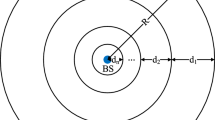Abstract
This paper presents an adaptive beacon scheduling mechanism using power control in cluster-tree network. We consider the emerging low-rate wireless personal area networks (LR-WPANs) technology as specified in the IEEE 802.15.4 standard that can support environmental monitoring applications. Node clustering is a useful topology management approach to reduce channel contention and improve the network lifetime in wireless sensor networks. A cluster-tree network conforming to the IEEE 802.15.4 standard is formed by several coordinators that periodically send beacon frames to the nodes of their cluster. However, if these periodic beacon frames are sent without any particular scheduling, they will collide with each other and those nodes that wait for them will lose synchronization with their coordinators. The purpose of this paper is to overcome this problem by proposing an adaptive beacon scheduling mechanism using power control, cluster grouping, and the group identifier (GID) in cluster-tree WPANs. This mechanism is designed such that all of the sensing devices send the measured received power level back to their cluster heads (CHs), thus enabling them to adjust their transmission power level after the construction of the topology. Following this, the PAN coordinator divides all of the CHs into several cluster groups (CGs) in order to transmit their beacon frames simultaneously without encountering any direct or indirect beacon frame collision problems. The PAN coordinator selects the group heads (GHs) and assigns the GID for each cluster group. In addition, the PAN coordinator controls the beacon transmission time of all of the CHs and GHs in the CGs using the GID information located in the beacon frame of the PAN coordinator in order to avoid beacon frame collisions. Accordingly, the overall lifetime of the network in cluster-tree WPANs is prolonged by solving the problem of beacon frame collisions. We evaluated the performance of our scheme through a mathematical analysis and a series of simulations using the Network Simulator 2 (NS-2).
Similar content being viewed by others
References
Golmie N., Cypher D., Rebala O. (2005) Performance analysis of low rate wireless technologies for medical applications. Computer Communications Journal 28: 1266–1275
Golmie, N., Cypher, D., & Rebala, O. (2004). Performance evaluation of low rate WPANs for medical applications. In IEEE MILCOM.
Chevrollier, N., Montavont, N., & Golmie, N. (2005). Handovers and interference mitigation in healthcare environments. In IEEE MILCOM.
Heinzelman, W. R., Chandrakasan, A., & Balakrishnan, H. (2000). Energy-efficient communication protocols for wireless microsensor networks. In Proceedings of the Hawaii International Conference on Systems Sciences.
Koubaa, A., et al. (2006). Collision-free beacon scheduling mechanisms for IEEE 802.15.4/Zigbee Cluster-Tree Wireless Sensor Networks. IPP-HURRAY Technical Report, HURRAY-TR-061104.
Attia, M., Koubaa, A., & Alves, M. (2006). Beacon scheduling in cluster-tree IEEE 802.15.4/ZigBee Wireless Sensor Networks. IPP-HURRAY Technical Report, HURRAY-TR-060604.
Koubaa, A., Cunha, A., & Alves, M. (2007). A time division beacon scheduling mechanism for IEEE 802.15.4/Zigbee cluster-tree wireless sensor networks. IPP-HURRAY Technical Report, HURRAY-TR-070401.
Kim, K. H., & Kim, I. W. (2006). Sequential clustering-based beacon scheduling in hierarchically-extended wireless sensor network. APCC ’06 Asia-Pacific Conference, E-Publishing Inc.
Ferrari, M., & Pizziniaco, L. (2006). An adaptive scheme for active periods schedule in IEEE 802.15.4 Wireless Networks. E-Publishing Inc.
Lee, M., Zheng, J., & Liu, Y. (2004). Combined beacon scheduling proposal to IEEE 802.15.4b. IEEE P802.15.4 WG for WPANs.
Zigbee-Alliance. (2005). ZigBee Specification. http://www.zigbee.org.
IEEE-T.G.15.4b. IEEE 802.15 WPAN Task Group 4b (TG 4b). http://grouper.ieee.org/groups/802/15/pub/TG4b.html.
IEEE-T.G.15.4b. Wireless Medium Access Control (MAC) and Physical Layer (PHY) Specifications for Low-Rate Wireless Personal Area Networks (LR-WPANs). IEEE standard for Information Technology.
AL-Karaki J.N., Kamal A.E. (2004) Routing techniques in wireless sensor networks: A survey. IEEE Wireless Communications Magazine. 11(6): 6–28
Abbasi A.A., Younis M. (2007) A survey on clustering algorithms for wireless sensor networks. Computer Communications Journal 30: 2826–2841
Texas Instruments. Data Sheet for CC2420 2.4 GHz IEEE 802.15.4f/ZigBee RF Transceiver. http://www.chipcon.com/files/CC2420_Data_Sheet_1_4.pdf.
Timmons, N. F., & Scanlon, W. G. (2004). Analysis of the performance of IEEE 802.15.4 for Medical Sensor Body Area Networking. IEEE SECON.
Kohvakka, M., Kuorilehto, M., et al. (2006). Performance analysis of IEEE 802.15.4 and ZigBee for large-scale wireless sensor network applications. ACM Press, pp. 48–57.
Microchip Technology. Data Sheet for PIC18LF8720 Microcontroller. http://www.microchip.com/download/en/DeviceDoc/39609b.pdf.
Author information
Authors and Affiliations
Corresponding author
Rights and permissions
About this article
Cite this article
Cho, J., An, S. An Adaptive Beacon Scheduling Mechanism Using Power Control in Cluster-Tree WPANs. Wireless Pers Commun 50, 143–160 (2009). https://doi.org/10.1007/s11277-008-9581-3
Received:
Accepted:
Published:
Issue Date:
DOI: https://doi.org/10.1007/s11277-008-9581-3




